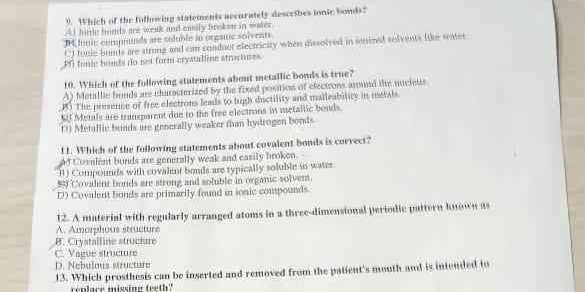Which of the following statements accurately describes ionic bonds? Which of the following statements about metallic bonds is true? Which of the following statements about covalent... Which of the following statements accurately describes ionic bonds? Which of the following statements about metallic bonds is true? Which of the following statements about covalent bonds is correct? A material with regularly arranged atoms in a three-dimensional periodic pattern known as? Which prosthetics can be inserted and removed from the patient's mouth and is intended to replace missing teeth?

Understand the Problem
The question involves multiple inquiries about the nature of different types of chemical bonds (ionic, metallic, covalent) and material structures. It appears to be a set of questions from a chemistry-related exam or quiz, focusing on key properties and characteristics of these bonds.
Answer
9. Ionic bonds strong and form crystals. 10. Metallic bonds have electron clouds. 11. Covalent bonds share electrons. 12. Crystal structure. 13. Dentures are removable.
- Ionic bonds are strong and form crystalline structures. 10. Metallic bonds are characterized by a sea of electrons allowing for conductivity. 11. Covalent bonds involve sharing of electrons and are directional. 12. A material with a periodic pattern is a crystal structure. 13. Removable prosthetics are dentures.
Answer for screen readers
- Ionic bonds are strong and form crystalline structures. 10. Metallic bonds are characterized by a sea of electrons allowing for conductivity. 11. Covalent bonds involve sharing of electrons and are directional. 12. A material with a periodic pattern is a crystal structure. 13. Removable prosthetics are dentures.
More Information
Ionic bonds form between metals and non-metals through electron transfer, creating a crystalline lattice. Metallic bonds involve a 'sea of electrons' that allow them to conduct electricity. Covalent bonds involve sharing electrons, are directional, and typically don't dissolve in water. Crystal structures have atoms in an ordered pattern.
Tips
A common mistake is confusing ionic bonds with covalent ones, but remember that ionic bonds involve electron transfer, whereas covalent bonds involve electron sharing.
AI-generated content may contain errors. Please verify critical information